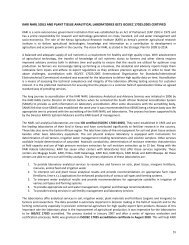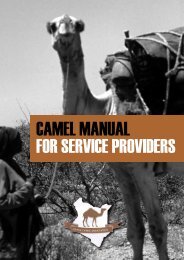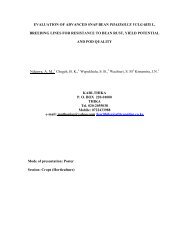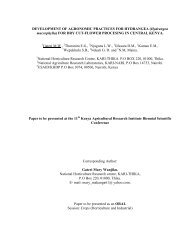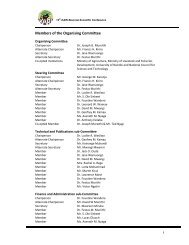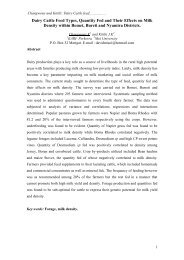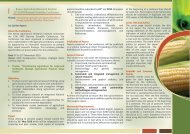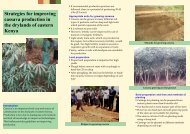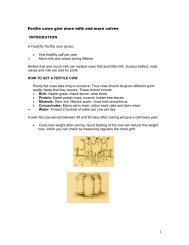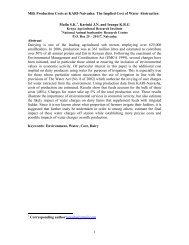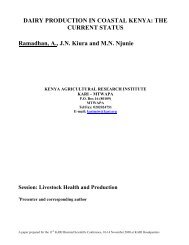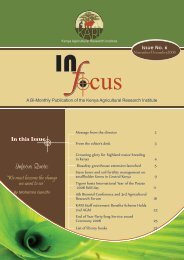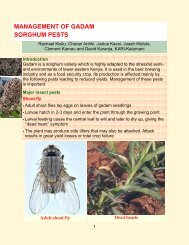January - June 2008 - Kenya Agricultural Research Institute
January - June 2008 - Kenya Agricultural Research Institute
January - June 2008 - Kenya Agricultural Research Institute
You also want an ePaper? Increase the reach of your titles
YUMPU automatically turns print PDFs into web optimized ePapers that Google loves.
The team visited Wilmar to see how the flowers were<br />
handled before export. Rosavie provided some finished<br />
flower products for viewing. The media team saw various<br />
stages of handling Mobydick after the flowers (bolls) were<br />
harvested. The farmer harvests and sorts the flowers for<br />
pest damage, length and colour among other quality<br />
attributes. The cut flowers are then taken to the buying<br />
centre nearby where they are graded into 1 st , 2 nd and other<br />
grades depending on the flower type. During the visit,<br />
the rate of rejection was high. Farmers were informed why<br />
the flowers were rejected and suggestions of nutritional<br />
or crop protective remedy were given by the buyer. Cut<br />
flowers are taken to the godown for various treatments<br />
before export. Mr. Kamami the CEO of Wilmar, conducted<br />
the media team around the premises. The main market<br />
destination for the cut flowers is the Allsmeer Auction in<br />
the Netherlands.<br />
The project has demonstrated that indeed flower<br />
farming is profitable to the smallholder growers. Field<br />
grown flowers require low financial and technological<br />
Farmers inspect flowers grown by Githunguri Sapewe Self<br />
Help Group<br />
input but are labour intensive. The labour intensive nature<br />
of horticulture makes both the old and young people<br />
gainfully occupied. Cut-flowers do not require a large area<br />
and in some areas this should be seen as a solution to the<br />
shrinking land sizes. The project should be up scaled to<br />
other areas where flower growing has a potential.<br />
KARI Packages Dissemination Materials for New Technologies<br />
By Koinange T. Mukundi and Geoffrey M. Kamau, KARI Headquarters<br />
... Just like the Safari Rally which tests car durability and provides manufacturers with feedback, technology brochures need<br />
pre-testing … (Dr E. Mukisira)<br />
The above were the words of the Director KARI when<br />
opening a four-day write-shop for KARI scientists<br />
on 6 th May, <strong>2008</strong> at the Agriculture Information<br />
Resource Centre, Kabete. He challenged the 31<br />
participating scientists from ten KARI centres to develop<br />
information packages for released agricultural<br />
technologies in order to catalyze uptake and adoption by<br />
the farming communities. The Director noted that<br />
scientists must strive to move the country forward by<br />
responding to demands of the farmers and other<br />
stakeholders. He observed that extension materials are<br />
vital because they help technology users to understand<br />
and use them as prescribed. He indicated that KARI would<br />
like the researchers on the ground to prescribe the<br />
specifications involved in particular technologies that<br />
make them work best for the farmer and the country. The<br />
Director advised the organsers to ensure that user<br />
feedback is captured appropriately during the pretesting<br />
process. Besides catalysing the adoption process, the<br />
scientists will also benefit from points awarded in the<br />
scientists’ evaluation, the Director added on these<br />
publications.<br />
Dr Mukisira noted that such information would assist<br />
to backstop technologies as take-away information for<br />
Farmer field schools, Farmer <strong>Research</strong> groups, <strong>Agricultural</strong><br />
Shows and is an important pathway of enhancing<br />
technology transfer and adoption. He recalled that KARI<br />
had successfully used <strong>Agricultural</strong> Technology and<br />
Information Response Initiative (ATIRI), with and now<br />
DSU (KAPP) as pathways of delivering information to<br />
farmers. He said KARI plans to establish a strong outreach<br />
division to proactively possess technology information<br />
to the public and challenged the participants to embrace<br />
Highlighter No. 23<br />
a culture of communicating technology information as<br />
soon as it is available. The Director pledged continued<br />
support to researchers to ensure full production of these<br />
vital information materials.<br />
Speaking in the same function, the Director of AIRC,<br />
Ms. Grace Agili, welcomed researchers and added that<br />
developers of technologies were best placed to advise<br />
on how they should be used for maximum benefit. She<br />
further emphasized the vital place of Agriculture in the<br />
development of the country. She cited a few of the<br />
constraints the sector was experiencing as moisture stress<br />
occasioned by low and unpredictable rainfall and<br />
welcomed the researchers to feel free to contribute to<br />
dissemination of information.<br />
The second write shop held from 9 th to 13 th <strong>June</strong><br />
attended by 32 scientists from 12 research centres at the<br />
same venue was opened by the Deputy Director Dr. J.G<br />
Mureithi who reiterated the Directors opening words. He<br />
stressed on the importance of clarity of the communication<br />
between the researchers and farmers. He pointed out that<br />
the write-shop was an important event that would go<br />
towards adding onto the past efforts in making the<br />
institute visible to the users and the taxpayers who are<br />
thirsty for this information. He emphasized on the<br />
importance of acquiring continuous feedback not only<br />
through pre-testing but also during the technology<br />
utilization stage. He also commended the task force<br />
members for their tireless efforts in the organization of<br />
the write shops.<br />
A total of 80 brochures covering technologies<br />
produced and packaged by most KARI programmes were<br />
developed. Pretesting has already started in various KARI<br />
centres pending final printing.<br />
8



